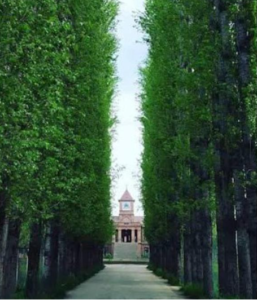The serene landscape of Srinagar, renowned for its natural beauty and cultural heritage, has recently been marred by controversy. The felling of 234 trees on a century-old college campus has sparked outrage among locals and alumni alike. Beyond being a mere act of environmental degradation, it symbolizes a clash between modern development aspirations and the preservation of historical and ecological heritage.

The college campus, nestled amidst the picturesque surroundings of Srinagar, holds a significant place in the history of the region. Established over a century ago, it has served as a bastion of education and enlightenment for generations. Its sprawling grounds and leafy canopies not only provided a conducive environment for learning but also contributed to the city’s ecological balance.
The decision to fell 234 trees on the college campus has ignited a fierce debate. While authorities cite reasons such as infrastructure expansion and development projects, critics argue that such actions come at an irreparable cost. The loss of these trees not only diminishes the aesthetic appeal of the campus but also poses a threat to the local ecosystem and biodiversity.
Locals and alumni, deeply connected to the college and its surroundings, have been at the forefront of the protest against the tree felling. For them, it’s not merely about preserving greenery but also about safeguarding the cultural and historical essence of their beloved institution. Their voices echo a sentiment of reverence for nature and a plea for responsible development practices.
Amidst the uproar, questions arise about the adequacy of environmental impact assessments conducted prior to the tree felling. Transparency and stakeholder engagement are paramount in such decisions, yet concerns have been raised regarding the lack thereof. Without a comprehensive understanding of the ecological ramifications, irreversible damage could be inflicted upon the fragile ecosystem.
The legality and ethicality of the tree felling also come under scrutiny. While authorities may argue in favor of development imperatives, the question remains whether alternative solutions were explored exhaustively. Additionally, adherence to environmental regulations and principles of sustainable development is imperative to ensure that short-term gains do not compromise long-term well-being.
In light of the controversy, it becomes imperative to explore alternative approaches that reconcile development aspirations with conservation imperatives. Strategies such as urban forestry, green infrastructure development, and adaptive reuse of existing structures offer viable solutions to achieve sustainable progress without sacrificing natural assets.
The outcry over the tree felling underscores the importance of public participation and civil society activism in governance processes. Engaging stakeholders in decision-making fosters a sense of ownership and accountability, thereby promoting more inclusive and sustainable development practices. The incident serves as a rallying call for citizens to actively advocate for the protection of their environmental and cultural heritage.
The controversy surrounding the felling of 234 trees on the century-old college campus in Srinagar serves as a sobering reminder of the delicate balance between development and conservation. It highlights the need for greater transparency, stakeholder engagement, and adherence to environmental norms in decision-making processes. Moving forward, concerted efforts must be made to prioritize sustainability and preserve the rich tapestry of our natural and cultural heritage.
The felling of trees on the century-old college campus in Srinagar has stirred emotions and sparked a dialogue on the intersection of development, conservation, and heritage preservation. It is not merely a local issue but a reflection of broader challenges faced by societies worldwide in navigating the complexities of progress while safeguarding the environment. Ultimately, it calls for a collective commitment to fostering a harmonious relationship between humanity and nature for the betterment of present and future generations.





